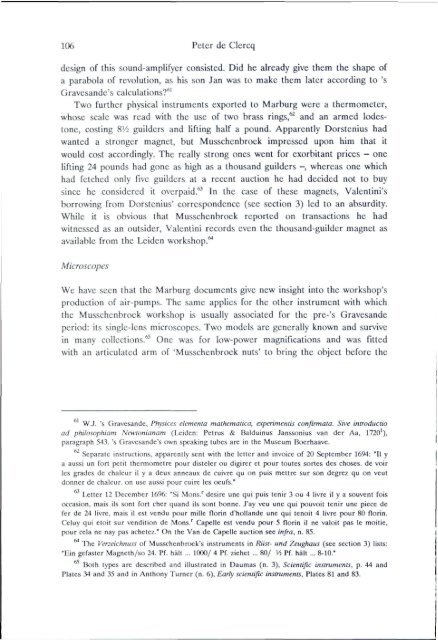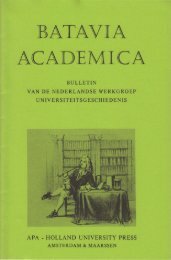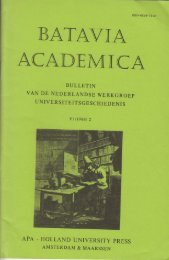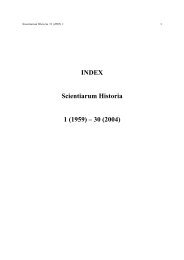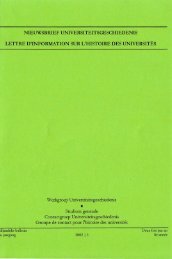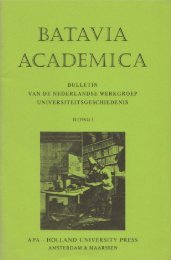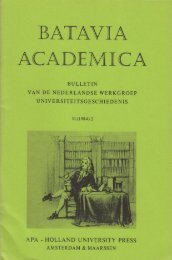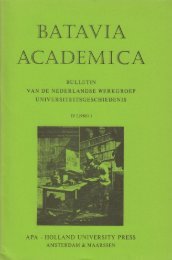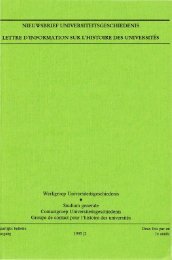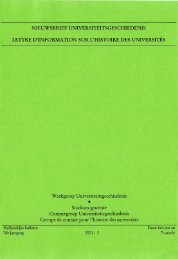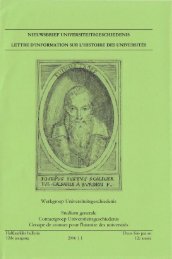EXPORTING SCIENTIFIC INSTRUMENTS AROUND 1700 - Gewina
EXPORTING SCIENTIFIC INSTRUMENTS AROUND 1700 - Gewina
EXPORTING SCIENTIFIC INSTRUMENTS AROUND 1700 - Gewina
You also want an ePaper? Increase the reach of your titles
YUMPU automatically turns print PDFs into web optimized ePapers that Google loves.
106 Peter de Clercq<br />
design of this sound-amplifyer consisted. Did he already give them the shape of<br />
a parabola of revolution, as his son Jan was to make them later according to 's<br />
Gravesande's calculations?"'<br />
Two further physical instruments exported to Marburg were a thermometer,<br />
whose scale was read with the use of two brass rings," and an armed lodestone,<br />
costing 8'/: guilders and lifting half a pound. Apparently Dorstenius had<br />
wanted a stronger magnet, but Musschenbroek impressed upon him that it<br />
would cost accordingly. The really strong ones went for exorbitant prices - one<br />
lifting 24 pounds had gone as high as a thousand guilders -, whereas one which<br />
had fetched only five guilders at a recent auction he had decided not to buy<br />
since he considered it overpaid.*' In the case of these magnets, Valentini's<br />
borrowing from Dorstenius' correspondence (see section 3) led to an absurdity.<br />
While it is obvious that Musschenbroek reported on transactions he had<br />
witnessed as an outsider, Valentini records even the thousand-guilder magnet as<br />
available from the Leiden workshop.**<br />
Microscopes<br />
We have seen that the Marburg documents give new insight into the workshop's<br />
production of air-pumps. The same applies for the other instrument with which<br />
the Musschenbroek workshop is usually associated for the pre-'s Gravesande<br />
period: its single-lens microscopes. Two models are generally known and survive<br />
in many collections." One was for low-power magnifications and was fitted<br />
with an articulated arm of 'Musschenbroek nuts' to bring the object before the<br />
W.J, 's Gravesande, Physices elementa mathemalica, experimentis confirmata. Si\v introductio<br />
ad philosophiam Ncwtonianam (Ix:iden: Petrus & Balduinus Janssonius van der Aa, 1720'),<br />
paragraph 543, 's Gravesande's own speaking tubes arc in the Mu.seum Bt^erhaave,<br />
Separate instructions, apparently sent with the letter and invoice of 20 September 1694: "II y<br />
a au.ssi un fort petit Ihcrmometre pour disteler ou digirer et pour toutes sortes des choses, de voir<br />
les grades de chalcur il y a deux anneaux de cuivre qu on puis mettre sur son degrez qu on veut<br />
donner de chaleur, on use aussi pour cuire les oeufs,"<br />
Letter 12 December 1696: "Si Mens,' desire une qui puis tenir 3 ou 4 livre il y a souvent fois<br />
occasion, mais ils sont fort cher quand ils sont bonne. J'ay veu une qui pouvoil tenir une piece de<br />
fer de 24 livre. mais il est vendu pour mille florin d'hollande une qui tenoit 4 livre pour 80 florin.<br />
Celuy qui etoit sur vendition de Mons,"^ Capelle est vendu pour 5 florin il ne valoit pas le moitie,<br />
pour cela ne nay pas achetez." On the Van de Capelle auction see infra, n. 85.<br />
The Verzeichnuss of Musschenbroek's instruments in Riist- und Zeughaus (see section 3) lists:<br />
"Bin gefaster Magneth/so 24. Pf. halt ... 1000/ 4 Pf. ziehet ... 80/ V: Pf. halt ... 8-10,"<br />
Both tjpes are described and illustrated in Daumas (n. 3), Scientific instruments, p. 44 and<br />
Plates 34 and .35 and in Anthony Turner (n. 6), Early scientific instruments. Plates 81 and 83.


